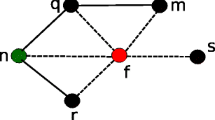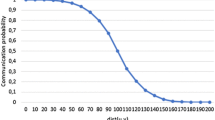Abstract
Hierarchical approaches, where nodes are clustered based on their network distances, have been shown to allow for robust and scalable topology-aware overlays. Moreover, recent research works have shown that cluster-based deployments of Internet Coordinates Systems (ICS), where nodes estimate both intra-cluster and inter-cluster distances, do mitigate the impact of Triangle Inequality Violations (TIVs) on the distance predictions, and hence offer more accurate internet latency estimations. To allow the construction of such useful clusters we propose a self-organized distributed clustering scheme. For better scalability and efficiency, our algorithm uses the coordinates of a subset of nodes, known by running an ICS system, as first approximations of node positions. We designed and evaluated two variants of this algorithm. The first one, based on some cooperation among nodes, aims at reducing the expected time to construct clusters. The second variant, where nodes are selfish, aims at reducing the induced communication overhead.
Preview
Unable to display preview. Download preview PDF.
Similar content being viewed by others
References
Ng, T.S.E., Zhang, H.: Predicting Internet network distance with coordinates-based approaches. In: Proc. IEEE INFOCOM, New York, NY, USA (June 2002)
Dabek, F., Cox, R., Kaashoek, F., Morris, R.: Vivaldi: A decentralized network coordinate system. In: Proc. ACM SIGCOMM, Portland, OR, USA (August 2004)
Zheng, H., Lua, E.K., Pias, M., Griffin, T.: Internet Routing Policies and Round-Trip-Times. In: Dovrolis, C. (ed.) PAM 2005. LNCS, vol. 3431. Springer, Heidelberg (2005)
Lua, E.K., Griffin, T.: Embeddable overlay networks. In: IEEE Symposium on Computers and Communications, Aveiro, Portugal (2007)
Kaafar, M.A., Gueye, B., Cantin, F., Leduc, G., Mathy, L.: Towards a two-tier internet coordinate system to mitigate the impact of triangle inequality violations. In: Das, A., Pung, H.K., Lee, F.B.S., Wong, L.W.C. (eds.) NETWORKING 2008. LNCS, vol. 4982, pp. 397–408. Springer, Heidelberg (2008)
Lua, E.K., Zhou, X., Crowcroft, J., Mieghem, P.V.: Scalable multicasting with network-aware geometric overlay. Comput. Commun. 31(3), 464–488 (2008)
He, Y., Zhao, Q., Zhang, J., Wu, G.: Topology-aware multi-cluster architecture based on efficient index techniques. In: Jin, H., Reed, D., Jiang, W. (eds.) NPC 2005. LNCS, vol. 3779, pp. 163–171. Springer, Heidelberg (2005)
Xue, G., Jiang, Y., You, Y., Li, M.: A topology-aware hierarchical structured overlay network based on locality sensitive hashing scheme. In: UPGRADE, New York, NY, USA, pp. 3–8. ACM, New York (2007)
Heyer, L.J., Kruglyak, S., Yooseph, S.: Exploring expression data: Identification and analysis of coexpressed genes. Genome Research 9(11), 1106–1115 (1999)
A simulator for peer-to-peer protocols, http://www.pdos.lcs.mit.edu/p2psim/index.html
Wong, B., Slivkins, A., Sirer, E.: Meridian: A lightweight network location service without virtual coordinates. In: Proc. the ACM SIGCOMM (August 2005)
R Development Core Team, R: A Language and Environment for Statistical Computing, R Foundation for Statistical Computing, Vienna, Austria (2008) ISBN 3-900051-07-0
Liu, X., Lan, J., Shenoy, P., Ramaritham, K.: Consistency maintenance in dynamic peer-to-peer overlay networks. Comput. Netw. 50(6), 859–876 (2006)
Author information
Authors and Affiliations
Editor information
Editors and Affiliations
Rights and permissions
Copyright information
© 2008 Springer-Verlag Berlin Heidelberg
About this paper
Cite this paper
Cantin, F., Gueye, B., Kaafar, M.A., Leduc, G. (2008). A Self-Organized Clustering Scheme for Overlay Networks. In: Hummel, K.A., Sterbenz, J.P.G. (eds) Self-Organizing Systems. IWSOS 2008. Lecture Notes in Computer Science, vol 5343. Springer, Berlin, Heidelberg. https://doi.org/10.1007/978-3-540-92157-8_6
Download citation
DOI: https://doi.org/10.1007/978-3-540-92157-8_6
Publisher Name: Springer, Berlin, Heidelberg
Print ISBN: 978-3-540-92156-1
Online ISBN: 978-3-540-92157-8
eBook Packages: Computer ScienceComputer Science (R0)




